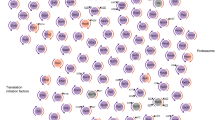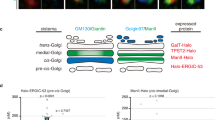Abstract
The organelles within secretory and endocytotic pathways in mammalian cells have acidified lumens, and regulation of their acidic pH is critical for the trafficking, processing and glycosylation of cargo proteins and lipids, as well as the morphological integrity of the organelles. How organelle lumen acidification is regulated, and how luminal pH elevation disturbs these fundamental cellular processes, is largely unknown. Here, we describe a novel molecule involved in Golgi acidification. First, mutant cells defective in Golgi acidification were established that exhibited delayed protein transport, impaired glycosylation and Golgi disorganization. Using expression cloning, a novel Golgi-resident multi-transmembrane protein, named Golgi pH regulator (GPHR), was identified as being responsible for the mutant cells. After reconstitution in planar lipid bilayers, GPHR exhibited a voltage-dependent anion-channel activity that may function in counterion conductance. Thus, GPHR modulates Golgi functions through regulation of acidification.
This is a preview of subscription content, access via your institution
Access options
Subscribe to this journal
Receive 12 print issues and online access
$209.00 per year
only $17.42 per issue
Buy this article
- Purchase on Springer Link
- Instant access to full article PDF
Prices may be subject to local taxes which are calculated during checkout







Similar content being viewed by others

References
Weisz, O. A. Organelle acidification and disease. Traffic 4, 57–64 (2003).
Tartakoff, A., Vassalli, P. & Detraz, M. Comparative studies of intracellular transport of secretory proteins. J. Cell Biol. 79, 694–707 (1978).
Palokangas, H., Metsikko, K. & Vaananen, K. Active vacuolar H+ATPase is required for both endocytic and exocytic processes during viral infection of BHK-21 cells. J. Biol. Chem. 269, 17577–17585 (1994).
Presley, J. F., Mayor, S., McGraw, T. E., Dunn, K. W. & Maxfield, F. R. Bafilomycin A1 treatment retards transferrin receptor recycling more than bulk membrane recycling. J. Biol. Chem. 272, 13929–13936 (1997).
Axelsson, M. A. et al. Neutralization of pH in the Golgi apparatus causes redistribution of glycosyltransferases and changes in the O-glycosylation of mucins. Glycobiology 11, 633–644 (2001).
Rivinoja, A., Kokkonen, N., Kellokumpu, I. & Kellokumpu, S. Elevated Golgi pH in breast and colorectal cancer cells correlates with the expression of oncofetal carbohydrate T-antigen. J. Cell. Physiol. 208, 167–174 (2006).
Puri, S., Bachert, C., Fimmel, C. J. & Linstedt, A. D. Cycling of early Golgi proteins via the cell surface and endosomes upon lumenal pH disruption. Traffic 3, 641–653 (2002).
Chapman, R. E. & Munro, S. Retrieval of TGN proteins from the cell surface requires endosomal acidification. EMBO J. 13, 2305–2312 (1994).
Reaves, B. & Banting, G. Vacuolar ATPase inactivation blocks recycling to the trans-Golgi network from the plasma membrane. FEBS Lett. 345, 61–66 (1994).
Kellokumpu, S., Sormunen, R. & Kellokumpu, I. Abnormal glycosylation and altered Golgi structure in colorectal cancer: dependence on intra-Golgi pH. FEBS Lett. 516, 217–224 (2002).
Weisz, O. A. Acidification and protein traffic. Int. Rev. Cytol. 226, 259–319 (2003).
Stobrawa, S. M. et al. Disruption of ClC-3, a chloride channel expressed on synaptic vesicles, leads to a loss of the hippocampus. Neuron 29, 185–196 (2001).
Piwon, N., Gunther, W., Schwake, M., Bosl, M. R. & Jentsch, T. J. ClC-5 Cl- -channel disruption impairs endocytosis in a mouse model for Dent's disease. Nature 408, 369–373 (2000).
Andresson, T., Sparkowski, J., Goldstein, D. J. & Schlegel, R. Vacuolar H+-ATPase mutants transform cells and define a binding site for the papillomavirus E5 oncoprotein. J. Biol. Chem. 270, 6830–6837 (1995).
Moriyama, Y. & Nelson, N. H+-translocating ATPase in Golgi apparatus. Characterization as vacuolar H+-ATPase and its subunit structures. J. Biol. Chem. 264, 18445–18450 (1989).
Glickman, J., Croen, K., Kelly, S. & Al-Awqati, Q. Golgi membranes contain an electrogenic H+ pump in parallel to a chloride conductance. J. Cell Biol. 97, 1303–1308 (1983).
Xie, X. S., Stone, D. K. & Racker, E. Determinants of clathrin-coated vesicle acidification. J. Biol. Chem. 258, 14834–14838 (1983).
Hara-Chikuma, M. et al. ClC-3 chloride channels facilitate endosomal acidification and chloride accumulation. J. Biol. Chem. 280, 1241–1247 (2005).
Grabe, M. & Oster, G. Regulation of organelle acidity. J. Gen. Physiol. 117, 329–344 (2001).
Llopis, J., McCaffery, J. M., Miyawaki, A., Farquhar, M. G. & Tsien, R. Y. Measurement of cytosolic, mitochondrial, and Golgi pH in single living cells with green fluorescent proteins. Proc. Natl Acad. Sci. USA 95, 6803–6808 (1998).
Schapiro, F. B. & Grinstein, S. Determinants of the pH of the Golgi complex. J. Biol. Chem. 275, 21025–21032 (2000).
Wu, M. M. et al. Organelle pH studies using targeted avidin and fluorescein-biotin. Chem. Biol. 7, 197–209 (2000).
Wu, M. M. et al. Mechanisms of pH regulation in the regulated secretory pathway. J. Biol. Chem. 276, 33027–33035 (2001).
Demaurex, N., Furuya, W., D'Souza, S., Bonifacino, J. S. & Grinstein, S. Mechanism of acidification of the trans-Golgi network (TGN). In situ measurements of pH using retrieval of TGN38 and furin from the cell surface. J. Biol. Chem. 273, 2044–2051 (1998).
Nishi, T. & Forgac, M. The vacuolar H+-ATPases — nature's most versatile proton pumps. Nature Rev. Mol. Cell Biol. 3, 94–103 (2002).
Pusch, M., Zifarelli, G., Murgia, A. R., Picollo, A. & Babini, E. Channel or transporter? The CLC saga continues. Exp. Physiol. 91, 149–152 (2006).
Jentsch, T. J. Chloride and the endosomal-lysosomal pathway: emerging roles of CLC chloride transporters. J. Physiol. 578, 633–640 (2007).
Duncan, R. R., Westwood, P. K., Boyd, A. & Ashley, R. H. Rat brain p64H1, expression of a new member of the p64 chloride channel protein family in endoplasmic reticulum. J. Biol. Chem. 272, 23880–23886 (1997).
Nagasawa, M., Kanzaki, M., Iino, Y., Morishita, Y. & Kojima, I. Identification of a novel chloride channel expressed in the endoplasmic reticulum, golgi apparatus, and nucleus. J. Biol. Chem. 276, 20413–20418 (2001).
Nordeen, M. H., Jones, S. M., Howell, K. E. & Caldwell, J. H. GOLAC: an endogenous anion channel of the Golgi complex. Biophys. J. 78, 2918–2928 (2000).
Thompson, R. J., Nordeen, M. H., Howell, K. E. & Caldwell, J. H. A large-conductance anion channel of the Golgi complex. Biophys. J. 83, 278–289 (2002).
Hara-Chikuma, M., Wang, Y., Guggino, S. E., Guggino, W. B. & Verkman, A. S. Impaired acidification in early endosomes of ClC-5 deficient proximal tubule. Biochem. Biophys. Res. Commun. 329, 941–946 (2005).
Miesenbock, G., De Angelis, D. A. & Rothman, J. E. Visualizing secretion and synaptic transmission with pH-sensitive green fluorescent proteins. Nature 394, 192–195 (1998).
Kim, J. H. et al. Dynamic measurement of the pH of the Golgi complex in living cells using retrograde transport of the verotoxin receptor. J. Cell Biol. 134, 1387–1399 (1996).
Farinas, J. & Verkman, A. S. Receptor-mediated targeting of fluorescent probes in living cells. J. Biol. Chem. 274, 7603–7606 (1999).
Yamashiro, D. J. & Maxfield, F. R. Acidification of morphologically distinct endosomes in mutant and wild-type Chinese hamster ovary cells. J. Cell Biol. 105, 2723–2733 (1987).
Paroutis, P., Touret, N. & Grinstein, S. The pH of the secretory pathway: measurement, determinants, and regulation. Physiology 19, 207–215 (2004).
Johnson, L. S., Dunn, K. W., Pytowski, B. & McGraw, T. E. Endosome acidification and receptor trafficking: bafilomycin A1 slows receptor externalization by a mechanism involving the receptor's internalization motif. Mol. Biol. Cell 4, 1251–1266 (1993).
Laver, D. R. & Peter, W. G. Interpretation of substates in ion channels: unipores or multipores? Prog. Biophys Mol. Biol. 67, 99–140 (1997).
Scheel, O., Zdebik, A. A., Lourdel, S. & Jentsch, T. J. Voltage-dependent electrogenic chloride/proton exchange by endosomal CLC proteins. Nature 436, 424–427 (2005).
Graves, A. R., Curran, P. K., Smith, C.L. & Mindell, J.A. The Cl−/H+ antiporter ClC-7 is the primary chloride permeation pathway in lysosomes. Nature 453, 788–792 (2008).
Wright, E. M. & Diamond, J. M. Anion selectivity in biological systems. Physiol Rev. 57, 109–156 (1977).
Koike, M. et al. Cathepsin D deficiency induces lysosomal storage with ceroid lipofuscin in mouse CNS neurons. J. Neurosci. 20, 6898–6906 (2000).
Ide, T. & Yanagida, T. An artificial lipid bilayer formed on an agarose-coated glass for simultaneous electrical and optical measurement of single ion channels. Biochem. Biophys. Res. Commun. 265, 595–599 (1999).
Acknowledgements
We thank F. Mori and K. Kinoshita for excellent technical assistance, and K. Nakamura for help with the cell sorting. We also thank T. Yoshimori, S. Kimura and H. Oomori for allowing us to use confocal and electron microscopes and for technical direction, and H. Hibino, H. Takeshima and T. Yamazaki for helpful discussions. This work was supported by grants from the Precursory Research for Embryonic Science and Technology, Japan Science and Technology Agency (Y.M.), the Core Research for Evolutional Science and Technology, Japan Science and Technology Agency (T.K.) and the Ministry of Education, Culture, Sports, Science and Technology of Japan.
Author information
Authors and Affiliations
Contributions
T.I. performed the planar lipid-bilayer analyses. M.K. and Y.U. performed the electron microscopy analyses. Y.M. performed the other experiments. T.K. and Y.M. contributed to the planning of experiments and wrote the manuscript. All authors discussed the results and commented on the manuscript.
Corresponding author
Ethics declarations
Competing interests
The authors declare no competing financial interests.
Supplementary information
Supplementary Information
Supplementary Figures S1, S2, S3, S4, S5, S6, S7, S8, Supplementary Materials and Methods (PDF 2164 kb)
Rights and permissions
About this article
Cite this article
Maeda, Y., Ide, T., Koike, M. et al. GPHR is a novel anion channel critical for acidification and functions of the Golgi apparatus. Nat Cell Biol 10, 1135–1145 (2008). https://doi.org/10.1038/ncb1773
Received:
Accepted:
Published:
Issue Date:
DOI: https://doi.org/10.1038/ncb1773
This article is cited by
-
Dissecting the genetic landscape of GPCR signaling through phenotypic profiling in C. elegans
Nature Communications (2023)
-
Life, death and resurrection of plant GPCRs
Plant Molecular Biology (2023)
-
SLC4A2 anion exchanger promotes tumour cell malignancy via enhancing net acid efflux across golgi membranes
Cellular and Molecular Life Sciences (2021)
-
Characterization of ZmCOLD1, novel GPCR-Type G Protein genes involved in cold stress from Zea mays L. and the evolution analysis with those from other species
Physiology and Molecular Biology of Plants (2021)
-
Intestinal epithelial glycosylation in homeostasis and gut microbiota interactions in IBD
Nature Reviews Gastroenterology & Hepatology (2020)


